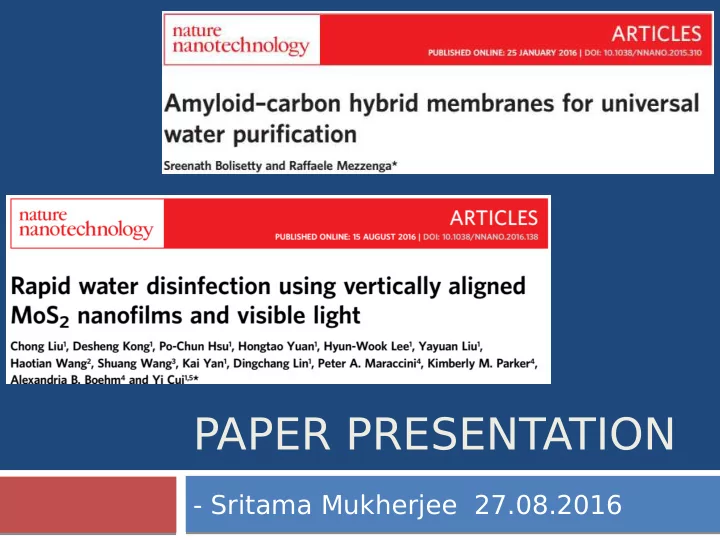

PAPER PRESENTATION - Sritama Mukherjee 27.08.2016
Membrane for UNIVERSAL water purifjcation? Prevalent techniques: Chemical precipitation- ~99% effjciency, causes secondary pollution, expensive, treats high contamination. Sorbents and Ion Exchange resins- 60-90% SPECIFICTY!! effjciency, costly, treat small volume waste water, secondary pollution Floatation or electrochemical treatment of waste water Membrane purifjcation- ~99% effjciency but high intrinsic costs, membrane fouling, limiting feed fmows
The background Science involved… Rufo and colleagues suggested that amyloid-forming peptides have a binding capability for zinc metal ions, which can catalyse fjbril formation. It has also been proposed that the toxicity of protein aggregates is due to binding of heavy metal ions to the peptides.
So, what they did is.. Hybrid membrane development amyloid fjbrils and activated Carbon Waste water purifjcation (heavy metal and nuclear waste) Simultaneous ion removal mode β-Lactoglobulin cheap edible milk protein amyloid fjbrils vacuum fjltration method. Sticky and stifg-enable assembly of amyloid fjbrils with carbon-based materials Mechanically strong composite membranes
Schematically, Heavy metal pollutants stud (KAu(CN) 2 ), (HgCl 2 ), (Pb(C 2 H 3 O 2 ) 4 ) a (Na 2 PdCl 4 )
Results and discussion: 50mL, 0.1L/min, 1.8 cm 2 area
Cont d.
Highlights: 10 × 50 mL = 0.5 L volume of water contaminated by mercury was processed using a 77 mg membrane containing only 7.4 wt% protein, that is, 5.7 mg, nearly 90,000 times less than the quantity of processed contaminated water. By extrapolating, 1 kg of protein could be used to treat 90,000 L of contaminated water. Fitting Parameters to fjt Metal adsorption isotherm
Recovery: Pollutant to valuable material
Summary: Development of a hybrid composite membrane incorporating inexpensive and environmentally friendly β-lactoglobulin amyloid fibrils and activated carbon, and show that it can be used as a tool for the effjcient removal of heavy metal ion pollutants and radioactive waste from water. Demonstrated the case of expensive metal pollutants, the recovered ions can even be converted into valuable materials, turning a global risk challenge into a unique opportunity.
Characterization Band gap=1.55 eV
FLV-MoS 2 disinfection performance
Summary: Effjcient harvesting of visible light for photocatalytic water disinfection with a novel material, FLV-MoS2. By decreasing the domain size, the band gap of MoS2 was increased from 1.3 eV (bulk material) to 1.55 eV (FLV- MoS2). This enabled the FLV-MoS2 to generate ROS successfully for bacteria inactivation in water. The FLV-MoS2 showed a faster disinfection than the most-studied photocatalyst, TiO2. With the additional deposition of Cu or Au to assist electron–hole pair separation and also to catalyse the ROS production reactions, FLV-MoS2 showed a rapid inactivation of >99.999% bacteria in only 20 or 60 min, respectively.
What can be done.. • Our material is specifjc towards Arsenic. Can we achieve multiple ion trapping by incorporating some cheap fjbrils to our composite? • Also, our material has no light sensitivity, so our material can be given visible light disinfection property, apart from Ag disinfection. Thank You.
Recommend
More recommend